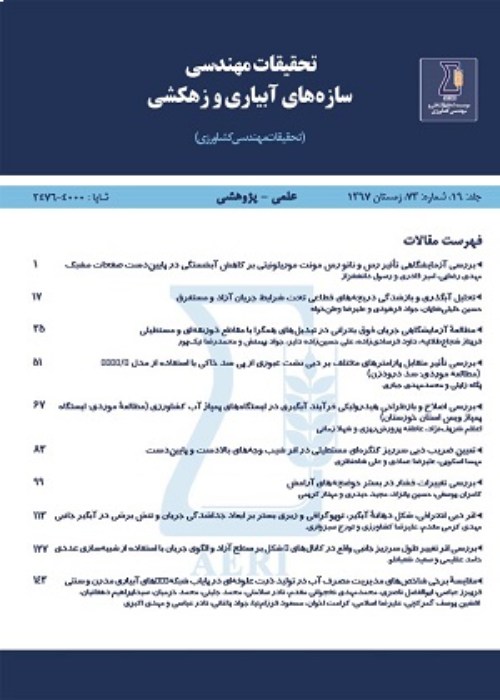Optimization of design parameters of underground drainage system using multi-global algorithm in steady state
The aim of this research is to optimize the design parameters of underground drainage systems with an economic approach. The study of the relationship between the depth and distance of drain installation has been the subject of many researchers, each of whom has tried to reduce the costs of drain implementation. In this research, genetic and multi-world algorithm optimization model was used to optimize the main design parameters of the underground drainage system of regional agricultural lands around Gorgan city. The area of the construction area of the drainage system was around 200 hectares. In this research, by using genetic and multi-world algorithm, the design parameters were selected in such a way that they lead to the lowest implementation cost of the underground drainage system. In this regard, the design parameters have been selected by combining Hohhot's permanent equation and optimization algorithms.
The area under study is Aliabad district, one of the functions of Gorgan city. The lands of Ali Abad region are also located in the upper part of the plains. These lands are located in eastern longitude and northern latitude. The study area covers about 200 hectares.
Genetic Algorithm:Genetic algorithm is an optimization method inspired by living nature, which can be referred to as a numerical method, direct and random search in classifications. This algorithm is based on repetition and its basic principles are adapted from genetic science.
Multi verse Algorithm:The big bang theory considers the occurrence of a big explosion as the beginning of the origin of our universe. According to this theory, the big bang is the origin of everything in this universe and nothing existed before it. A population-based algorithm performs the search process in two stages: exploration and exploitation. In this algorithm, the concepts of white hole and black hole are used to explore the search space. In contrast, wormholes help exploit search spaces.
Genetic Algorithm:By applying the genetic algorithm optimization model to the data of the studied lands, the optimal parameters were calculated. Table (4) shows the design parameters obtained from the genetic algorithm optimization model in different drainage coefficients for the allowed depth of drain installation. Considering the entire search area (permissible depth of drainage installation from 1.5 to 3.5 meters from the ground surface), the results obtained from the land input data of the studied area showed that taking into account the drainage coefficient of 2.5 mm per day, the minimum cost the equivalent of 51.3 million Tomans has happened in 8 hectares at a depth of 2.62 meters from the ground surface with an installation distance of 79.9 meters and a diameter of 125 mm.
Multiverse algorithm
The optimal parameters were calculated by applying the multi-world algorithm optimization model. Table (7) shows the design parameters obtained from the optimization model in different drainage coefficients for the allowed depth of drain installation. Considering the entire search area (permissible depth of drain installation from 1.5 to 3.5 meters from the ground surface), the results obtained from the input data of Aliabad lands showed that taking into account the drainage coefficient (discharge intensity) 2.5 mm per the minimum cost equivalent to 51.5 million Tomans has happened in an 8-hectare unit at a depth of 2.61 meters from the ground with an installation distance of 79.5 meters and a diameter of 125 mm.
Comparing the results of genetic and multiverse algorithms
Comparing the performance of genetic and multi-world algorithms shows the high efficiency of both algorithms in solving the problem of optimizing the diameter of drainage pipes and their installation depth. Both algorithms have almost the same performance in solving this optimization problem; So that both algorithms in the distance of the impervious layer to the depth of the drain installation (D) is equal to 2.25 meters, the stabilization depth of the water table (in the middle of the two drains) from the ground level (H) is equal to 1.5 meters and intensity Drainage or drainage from the surface unit (q) is equal to 4 mm per day, and they have calculated the optimal depth of drainage installation to be 13.3 meters
The design of drainage systems consists of choosing three parameters: depth, diameter and distance of drains. Various approaches can be used to choose the best combination of three parameters. One of the approaches can be to reduce the costs of implementing the drainage system. In this research, using the genetic algorithm, these parameters were selected in such a way that they lead to the lowest implementation cost of the drainage system. In this regard, the design parameters have been selected by combining Hohhot's permanent equation and genetic algorithm.
- حق عضویت دریافتی صرف حمایت از نشریات عضو و نگهداری، تکمیل و توسعه مگیران میشود.
- پرداخت حق اشتراک و دانلود مقالات اجازه بازنشر آن در سایر رسانههای چاپی و دیجیتال را به کاربر نمیدهد.



